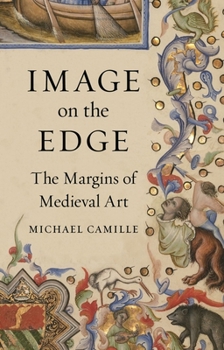Image on the Edge: The Margins of Medieval Art
Select Format
Select Condition 
Book Overview
What do they all mean--the lascivious ape, autophagic dragons, potbellied heads, harp-playing asses, arse-kissing priests, and somersaulting jongleurs to be found protruding from the edges of medieval buildings and in the margins of illuminated manuscripts? A groundbreaking, celebrated study of marginalia in mediaeval art, Michael Camille's Image on the Edge explores this riotous realm so often explained away as mere decoration or zany doodles, a...
Format:Hardcover
Language:English
ISBN:1789140064
ISBN13:9781789140064
Release Date:July 2019
Publisher:Reaktion Books
Length:208 Pages
Weight:1.10 lbs.
Dimensions:1.0" x 5.8" x 8.6"
Customer Reviews
2 ratings
The Luminous Colors of the Dark Ages.
Published by Thriftbooks.com User , 15 years ago
With 86 illustrations, 13 in full color. What do they all mean - the apes, the dragons, pot-bellied heads, and somersaulting jongleurs to be find protruding from the edges of medieval buildings and in the margins of illuminated manuscripts? Michael Camille explores that riotous realm of marginal art so often explained away as mere decorations or amusing doodles. He shows that the true nexus of innovation in the art of the time is not to be found where so many have sought it - within the heavily conventionalized centre - but on the edge, where resistance to medieval social constraints flourished. Medieval image-makers focused attention on the underside of society, the excluded and the ejected. These peasants, servants, prostitutes and beggars all found there place, along with knights and clerics, engaged in impudent antics in the margins of prayer-books or, as gargoyles, on the outside of churches. Camille brings us to an understanding of how marginality functioned in medieval culture and shows us just how scandalous, subversive and amazing the art of the time could be.
Fascinating Exploration of the Margins of Medieval Culture
Published by Thriftbooks.com User , 25 years ago
For readers unfamiliar with the culture of the Middle Ages, it is surprising, and perhaps even disconcerting, to learn that a medieval manuscript of a prayer-book could contain marginal images of human excrement, or that medieval churches were frequently adorned with gargoyles depicting diabolic and uncanny figures. This book by Michael Camille, professor of art history at the University of Chicago, is devoted to explaining these strange "margins" of medieval culture. Camille essentially argues that, while such marginal images could on the face of it be interpreted as subverting the conventions of the dominating center of culture, they ultimately served to reinforce it. As the author puts it on page 127, "the edges of discourse...always return us to the rules of the center." In other words, medieval artists toyed with the margins of culture, with "otherness" and difference, yet ultimately sided with the "good" and the "normal." Interestingly enough, the marginal images which were so typical of the high Middle Ages disappeared at the beginning of the modern age. Camille suggests that the margins lost their function of hinting at the ugly reverse of mainstream culture in an age where the mainstream both asserted itself more strongly, rigorously demarcating "low" from "high" culture, and at the same time dissolved difference in the medium of bourgeois taste. Peasants and drunkards, for example, became the explicit object of a genre called the "grotesque." At the end of this fine book, Camille writes: "art collapsed inwards, to create a more literal and myopic dead-center [devoid of the medieval playfulness], taking with it edges and all" (p. 160).





